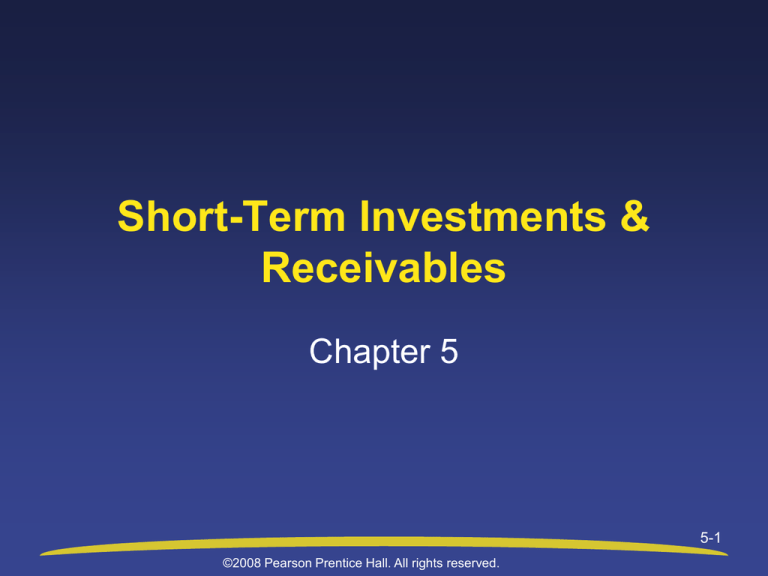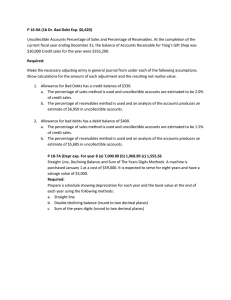
Short-Term Investments &
Receivables
Chapter 5
5-1
©2008 Pearson Prentice Hall. All rights reserved.
Learning Objective 1
Account for short-term investments
5-2
©2008 Pearson Prentice Hall. All rights reserved.
Accounting for Short-Term
Investments
•
•
•
•
Also called marketable securities
Held for one year or less
Most liquid asset other than cash
Placed into three categories:
Trading
Investments
Availablefor-Sale
Held-toMaturity
5-3
©2008 Pearson Prentice Hall. All rights reserved.
Trading Investments
• Held for short time and then sold
Gain or loss recorded
Selling price > cost = Gain
Selling price < cost = Loss
• Dividend revenue may also be received
• At year-end, trading investments are
adjusted to equal their market value
Results in an unrealized gain or loss
5-4
©2008 Pearson Prentice Hall. All rights reserved.
Unrealized Gains & Losses
• Difference between market price and cost
of investment at year-end
• Unrealized – investment has not been sold
Market price >
cost =
Unrealized gain
Market price <
cost =
Unrealized loss
5-5
©2008 Pearson Prentice Hall. All rights reserved.
Realized vs. Unrealized
Realized
• Investment sold to
third party
• Gain or loss =
difference between
selling price and cost
• Word “realized”
usually dropped from
title
Unrealized
• Company still owns
investment
• Gain or loss =
difference between
market value and cost
• Word “unrealized” is
kept in account title
5-6
©2008 Pearson Prentice Hall. All rights reserved.
Entries to Adjust to Market
JOURNAL
Date
Accounts
Debit
Short-term investments
$$$
Unrealized gain on investments
Credit
$$$
Adjusted investment to market value (when greater than cost)
Unrealized loss on investments
Short-term investments
$$$
$$$
Adjusted investment to market value (when less than cost)
5-7
©2008 Pearson Prentice Hall. All rights reserved.
Reporting on Financial Statements
Balance Sheet
• Trading Investment
Reported at current
market value
Listed directly under
“cash” in the current
asset section
Income Statement
• Gains and losses
From sales of
investments
• Investment revenue
From dividends or
interest earned
• Unrealized gain or
loss
From entry to adjust to
market value
5-8
©2008 Pearson Prentice Hall. All rights reserved.
E5-18
JOURNAL
Date
Accounts
Nov 6 Trading investment
Debit
$35,000
Cash
Nov 27 Cash
Dividend revenue
Credit
$35,000
$850
$850
5-9
©2008 Pearson Prentice Hall. All rights reserved.
E5-18
JOURNAL
Date
12-31
Accounts
Debit
Unrealized loss
What would be the
amount of the
Credit
unrealized loss?
_______
Trading Investments
________
Compute the difference
between the cost and
market value.
5-10
©2008 Pearson Prentice Hall. All rights reserved.
E5-18
JOURNAL
Date
1-11
Accounts
Debit
Cash
Credit
$36,000
Trading Investments
Gain on sale of investments
$33,000
$3,000
5-11
©2008 Pearson Prentice Hall. All rights reserved.
Receivables
• Monetary claims against others
• Third most liquid asset
• Accounts Receivable
Amounts owed by customers for selling goods
or services
• Notes Receivable
Lending money to outsiders
More formal than accounts receivable
5-12
©2008 Pearson Prentice Hall. All rights reserved.
Learning Objective 2
Apply internal controls to receivables
5-13
©2008 Pearson Prentice Hall. All rights reserved.
Internal Control over Cash
Collections on Account
• Separate cash-handling from cashaccounting duties
• Cash-handling
One person receives customer checks and
makes deposits
• Cash-accounting
Another person makes entries to customer
accounts
5-14
©2008 Pearson Prentice Hall. All rights reserved.
Accounting for Uncollectible
Receivables
• Extending credit to
customers bears
some risk
• Risk: Some
customers do not pay
the amount owed
• Cost: Uncollectible
accounts
5-15
©2008 Pearson Prentice Hall. All rights reserved.
Learning Objective 3
Use the allowance method for uncollectible
receivables
5-16
©2008 Pearson Prentice Hall. All rights reserved.
Allowance Method
• Amount of uncollectible accounts is
estimated
• An expense is recorded as part of the
adjusting process
• A contra-asset is recorded that reduces
accounts receivable on the balance sheet
A contra-asset is always paired
with an asset and reduces
its balance
5-17
©2008 Pearson Prentice Hall. All rights reserved.
Entry to Record Uncollectible
accounts
JOURNAL
Date
Accounts
Debit
Uncollectible accounts expense
Credit
Goes on the
Income Statement
Allowance for uncollectible accounts
Goes on the Balance Sheet
netted with accounts receivable
5-18
©2008 Pearson Prentice Hall. All rights reserved.
Balance Sheet
Current assets:
Accounts receivable
$$,$$$
Less: Allowance for
Uncollectible Accounts ( $,$$$)
Accounts receivable, net $$,$$$
OR
Accounts receivable, net
$$,$$$
5-19
©2008 Pearson Prentice Hall. All rights reserved.
Methods to Estimate Uncollectibles
Percent-of-sales
• Expense is estimated
based on credit sales
• Income Statement
approach
Aging-of-receivables
• Accounts receivable
analyzed based on
how long outstanding
• Balance Sheet
approach
5-20
©2008 Pearson Prentice Hall. All rights reserved.
E5-23
Age of Accounts
1 - 30 Days
31 - 60 Days
61 - 90 Days Over 90 Days
$
$
$
110,000
0.5%
$
550
60,000
50,000
1%
$
600
$
60%
$
30,000
15,000
40%
$
6,000
$37,150
5-21
©2008 Pearson Prentice Hall. All rights reserved.
E5-23
Aging Schedule
Balance in Allowance
Adjustment needed
= Aging schedule Balance
$37,150
$7,400
Adjustment needed
JOURNAL
Date
Accounts
Debit
12-31
Uncollectible accounts expense
_______
Allowance for uncollectible accounts
Credit
______
5-22
©2008 Pearson Prentice Hall. All rights reserved.
E5-23
Allowance for Uncollectible Accounts
$7,400
Adjusting entry
Balance before
adjustment
$29,750
$37,150
Balance per
aging
schedule
5-23
©2008 Pearson Prentice Hall. All rights reserved.
Uncollectible Accounts Methods
Percent-of-Sales
Adjust Allowance for
Uncollectible Accounts
Aging-of-Receivables
Adjust Allowance for
Uncollectible Accounts
BY
TO
The Amount of
UNCOLLECTIBLE ACCOUNT
EXPENSE
The Amount of
UNCOLLECTIBLE ACCOUNTS
RECEIVABLE
5-24
©2008 Pearson Prentice Hall. All rights reserved.
Writing Off a Specific Account
• The allowance is used to absorb specific
accounts that are determined to uncollectible
• When it’s determined a customer cannot pay,
the following entry is made:
JOURNAL
Date
Accounts
Debit
Allowance for uncollectible
accounts
Accounts receivable
Credit
$$$$
$$$$
5-25
©2008 Pearson Prentice Hall. All rights reserved.
Direct Write-Off Method
• Less preferable than allowance method
Does not match expenses with revenues
Accounts Receivable overstated
• Uncollectible Accounts Expense used for
write offs
• No Allowance for Uncollectible Accounts
5-26
©2008 Pearson Prentice Hall. All rights reserved.
Accounts Receivable
Sales on account
Payments on
account
Uncollectible
accounts written off
5-27
©2008 Pearson Prentice Hall. All rights reserved.
Allowance for Uncollectible Accounts
Uncollectible
accounts written off
Uncollectible account
adjustment
What is the
normal balance of
the Allowance?
5-28
©2008 Pearson Prentice Hall. All rights reserved.
Learning Objective 4
Account for notes receivable
5-29
©2008 Pearson Prentice Hall. All rights reserved.
Notes Receivable Terms
•
•
•
•
•
•
•
Creditor
Debtor
Interest
Maturity Date
Maturity Value
Principal
Term
Party to whom money is owed; lender
Party that owes money; borrower
Cost of borrowing money; percent
Date debtor must pay the note
Sum of principal and interest on note
Amount borrowed by debtor
Length of time money is borrowed
5-30
©2008 Pearson Prentice Hall. All rights reserved.
Accounting for Notes Receivable
• To record the receipt of a note
receivable, the following entry is made:
JOURNAL
Date
Accounts
Debit
Notes Receivable
Cash
Credit
$$,$$$
$$,$$$
5-31
©2008 Pearson Prentice Hall. All rights reserved.
Accounting for Notes Receivable
• Interest needs to be accrued on any
note receivable outstanding at year end:
JOURNAL
Date
Accounts
Debit
Interest receivable
Interest revenue
Interest is computed by the formula:
Principal x rate x time
Credit
$$,$$$
$$,$$$
Time = date note is
signed to end-of-year
5-32
©2008 Pearson Prentice Hall. All rights reserved.
Accounting for Notes Receivable
When payment is received on note, the following
entry is made
JOURNAL
Date
Accounts
Cash
Debit
Credit
For maturity value
Notes Receivable
Interest receivable
For principal
Zeroes out adjustment
Interest revenue
For remaining
interest earned
©2008 Pearson Prentice Hall. All rights reserved.
5-33
Credit and Bank Card Sales
• Credit Cards
American Express and Discover
• Bank Cards
VISA and MasterCard
• Both charge the retailer a fee
5-34
©2008 Pearson Prentice Hall. All rights reserved.
Learning Objective 5
Use two new ratios to evaluate a business
5-35
©2008 Pearson Prentice Hall. All rights reserved.
Days’ Sales in Receivables
• How long it takes a company to collect its
average amount of receivable
• Compute one day’s sales
Net Sales
365 Days
• Days’ sales in receivables
Average receivables
One Day’s Sales
5-36
©2008 Pearson Prentice Hall. All rights reserved.
Acid-Test Ratio
• Also called quick ratio
• A more stringent measure of a company’s
ability to pay its current liabilities
Cash + Short-term investments + net receivables
Total current liabilities
5-37
©2008 Pearson Prentice Hall. All rights reserved.
End of Chapter Five
5-38
©2008 Pearson Prentice Hall. All rights reserved.








